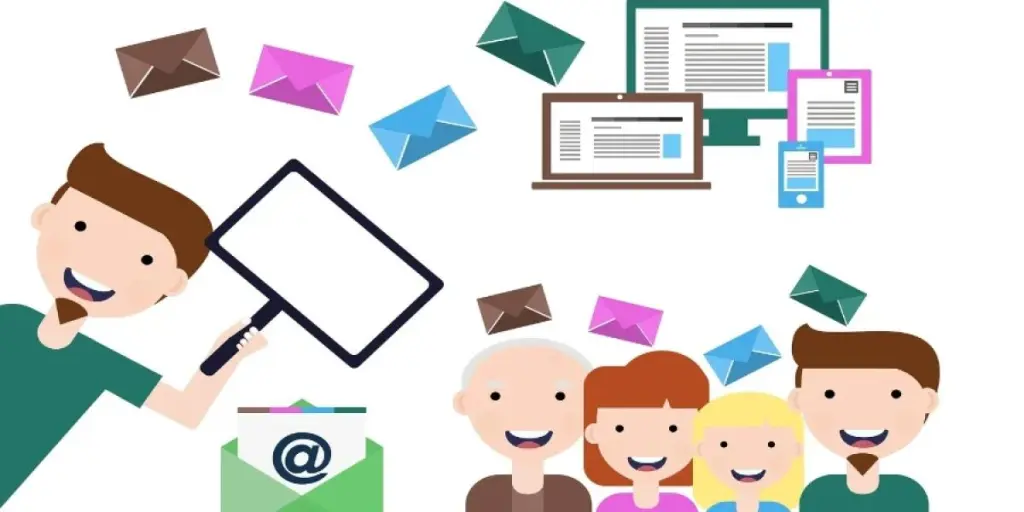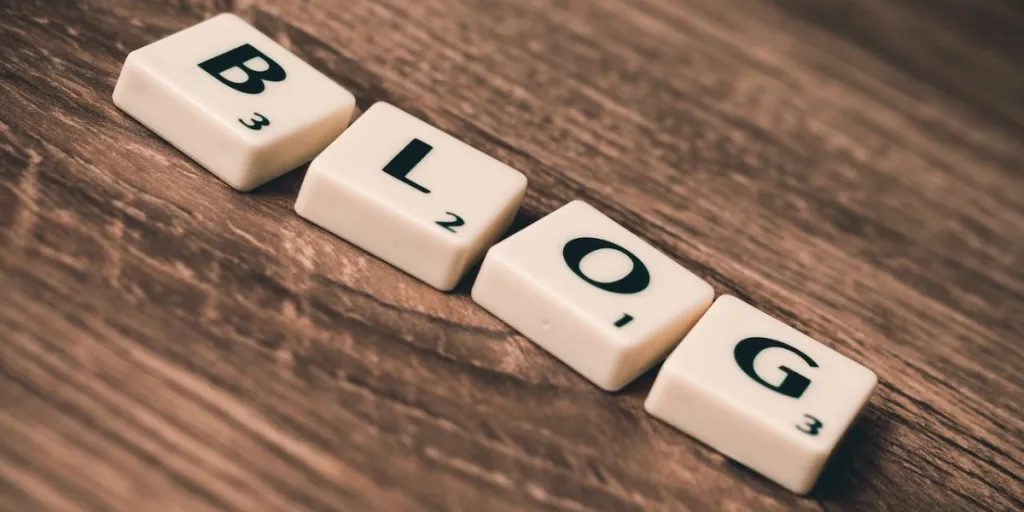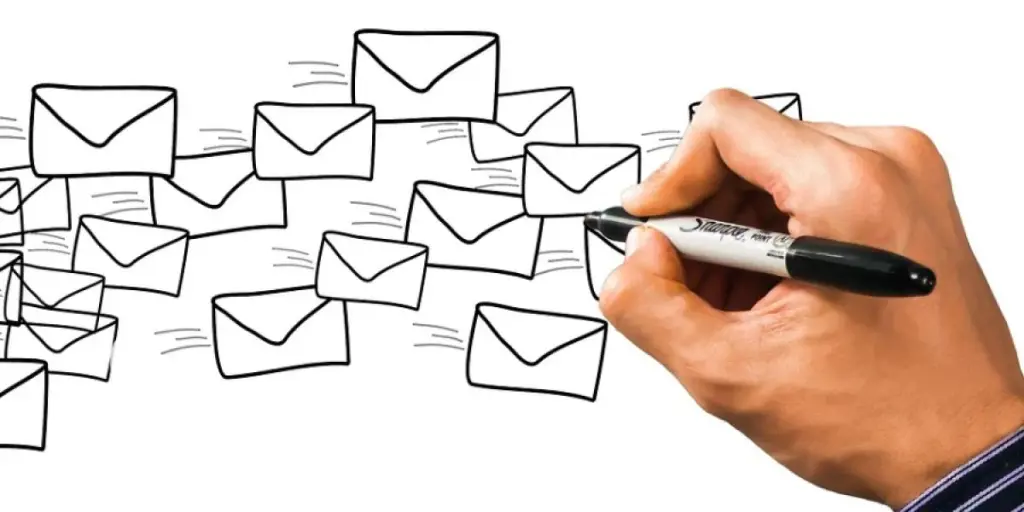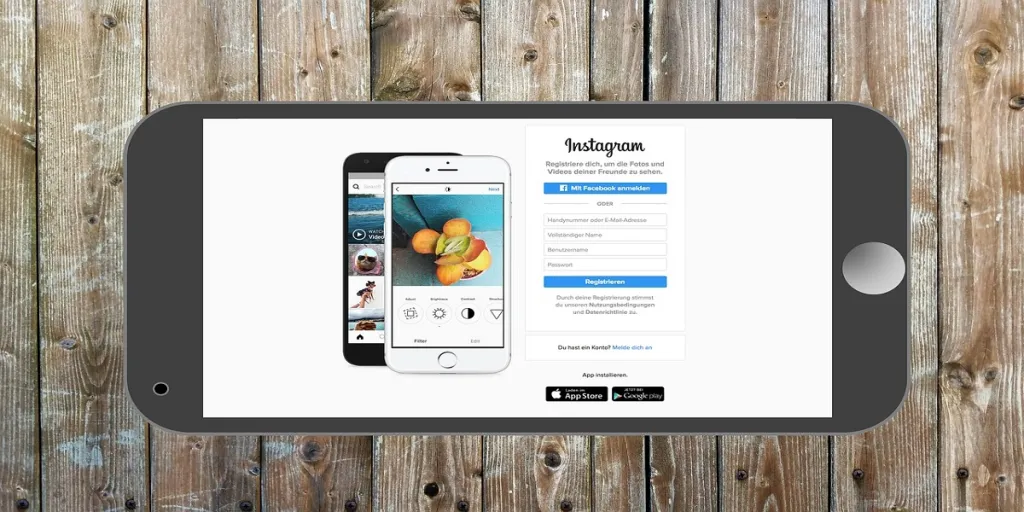Ever wondered what you should do to convert the visitors who leave your online store without completing their purchases?
Well, you can try email retargeting.
By using the information you have about your prospects, you can create relevant, highly-targeted email campaigns to drive them back to your website.
Let’s face it, not everyone who visits your website will make a purchase. But that doesn’t mean you should treat those people as a lost cause.
Retargeting emails allow you to engage these prospects with personalized content that encourages them to act.
Table of Content
What is email retargeting?
How does email retargeting work?
Retargeting email examples & best practices
How to create a retargeting email
Summary
What is email retargeting?
Email retargeting is the process of reaching out to users who have interacted with your brand but quit before taking the desired action. Tracking such users is possible by using browser cookies that collect and save information when users visit a website.
Email retargeting campaigns are commonly used to re-engage users who have shown an interest in your products but left without making a purchase. You can also use retargeting emails for upselling and cross-selling products to existing customers.
The image below is an example of email retargeting where a brand reaches out to a shopper who has abandoned their cart.
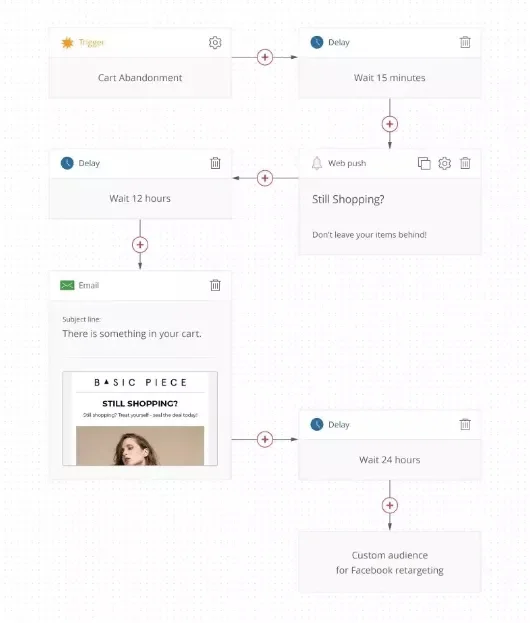
How does email retargeting work?
Email retargeting is a marketing strategy where brands use the information they have about their customers to create personalized emails that meet their needs.
For example, when a shopper browses products on your website and they leave without buying them, you can re-engage them with browse abandonment emails. Such emails encourage them to return to your website to finish their purchase. Here’s a visualization of how the process works.
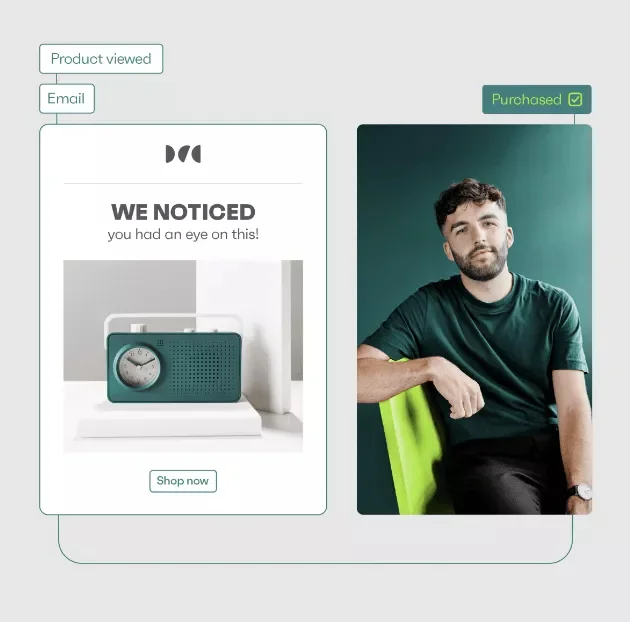
To succeed with email remarketing, you need to follow certain email retargeting best practices, which we’ll look at now.
1. Build your subscriber list
Email retargeting only allows you to reach out to users in your email list. That’s why the first thing you need to do to build a successful retargeting campaign is to build your email list.
The effective strategies you can use to build an email list include:
- Using popup forms on your website
- Adding a signup field at the footer of your website
- Encouraging your social media followers to sign up for your newsletter
2. Segment your audience
The next step is to define your audience into segments to make it easier for you to create relevant emails. Some of the characteristics you can use to segment your audience include:
- Cart status
- Product
- Purchase history
- Demographic
3. Create your email sequences
Methodically plan the emails you will send when a user fails to complete a desired action on your website. You don’t want to come off as spammy so take some time before reaching out to shoppers with a gentle reminder.
Retargeting email examples & best practices
Email marketing is an effective channel that ecommerce brands use to grow their businesses and remarketing is a tool that supports strategic communication on an already effective platform.
As with any other marketing strategy, there are email retargeting best practices you can use to run successful campaigns.
Below are seven retargeting email examples and best practices for executing the perfect campaigns:
- Abandoned cart email
- Browse abandonment email
- Back in stock email
- Upsell email
- Cross-sell email
- Replenishment email
- Win-back email
Abandoned cart email
Brand: Perigold
When users visit Perigold’s website and leave without checking out, the brand reaches out to them with personalized abandoned cart emails to motivate them to complete their purchase.
The email usually includes the products a user had in their cart to make it easy for them to checkout. They also include relevant product recommendations for each shopper to increase the cart value.
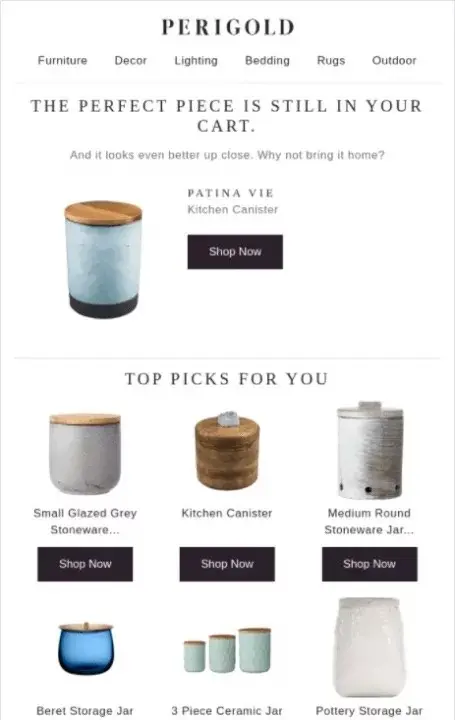
Here are some tips to get better results from your cart abandonment emails:
- Include all the products the users had in the cart
- Display trust badges and customer reviews to ease shoppers’ worries
- Enable guest checkout to simplify the checkout process
- Include other product recommendations that go with the items the user has in the cart
- Give the customers a discount to motivate them to complete the purchase
- Use a catchy subject line to get customers to open your remarketing emails
Browse abandonment email
Brand: ASOS
Sometimes, people browse products on your website and leave without adding them to a cart. You can reach out to these users with personalized emails and tell them about the products they browsed recently, just like ASOS does with its ‘window shoppers’ email.
The image below shows a browse abandonment email ASOS sent to a subscriber who viewed certain products on their website and left without buying.
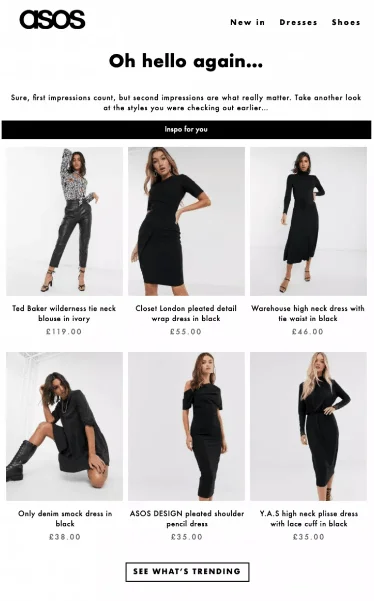
If you are facing similar challenges, use the following strategies to create retargeting emails to re-engage subscribers who have browsed products on your site.
- Include all the products the shopper has viewed on your site
- Add a button that allows the shopper to buy all the items
- Include a CTA that takes the users to see other products on your website
- Use a catchy headline to get the customer to open the email
- Add recommended products to the email
Back in stock email
Brand: Quince
Nothing is more frustrating for a shopper than finding the product they want to buy is out of stock. Such users can easily go to another store but you can delay their purchase and get them to buy from your store by promising to notify them when the product is back in stock.
To make this possible, add an email box on the product page to collect the user’s email like in the image below. Also, ask for permission to add the users to your subscriber list with a simple check box.
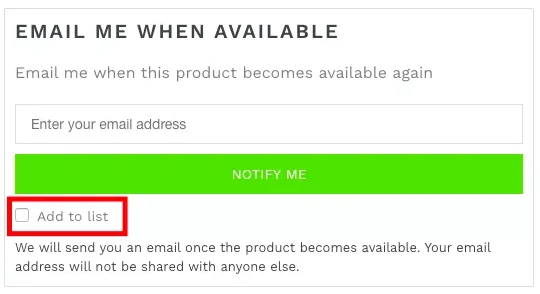
And when you finally restock the product, ensure to notify the user immediately as Quince does with their retargeting emails.
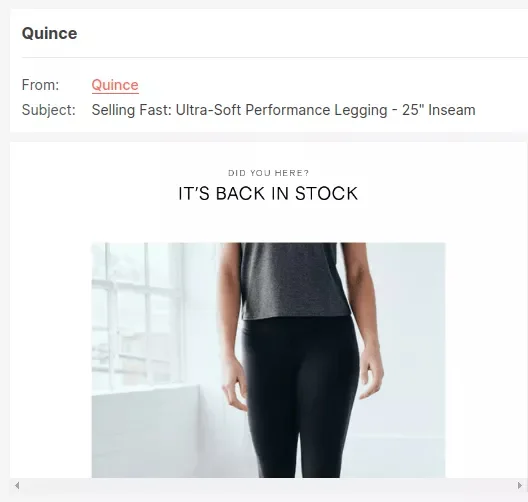
Use the following tips to succeed with your back in stock retargeting emails:
- Add a button that takes the shopper directly to checkout
- Recommend related products
- Add trust signals like reviews to dispel any worries the customer may have about the product
Cross-sell email
Brand: ELEKTRIKcity
Once you close an online sale, there’s still an opportunity to encourage the customer to buy more products with relevant post-purchase emails. For example, you can identify products that complement what the customer has already bought and recommend them through a cross-sell email.
In the example below, ELEKTRIKcity reaches out to a customer who has already purchased from its store. They thank the customer for their recent purchase and recommend other products the customer may need.
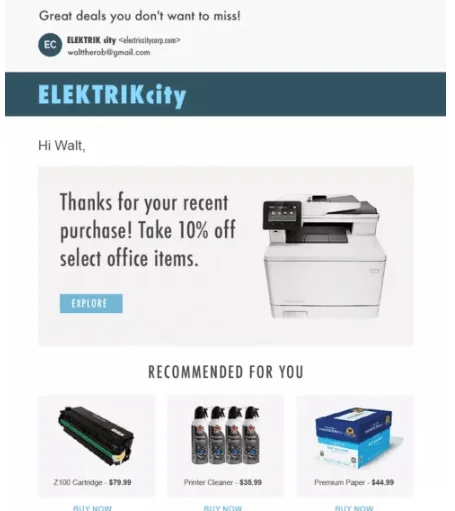
For your cross-sell email retargeting campaigns to be successful, you need to do the following:
- Include the product the customer has bought
- Add relevant product recommendations
- Be generous with your discounts to encourage customers to buy the recommended products
- Add buttons that take the customer directly to the product page to view the recommended products
Upsell email
Brand: Crate & Barrel
When a customer buys a product from your store, you can advise them to get another product with better features or buy other items that go well together with the product they’ve just bought.
Considering that the customer will have to pay more money to get the upgrade, upsell retargeting emails usually have an incentive, such as a discount, to encourage the shopper to take action.
Crate & Barrel uses this technique to recommend relevant products to its customers as you can see in the image below.
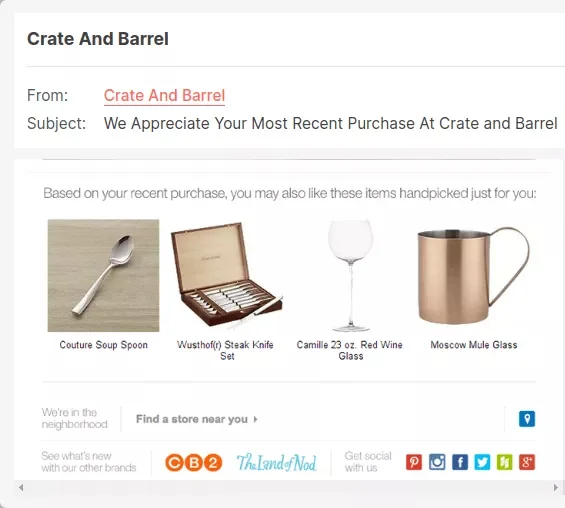
To succeed with this strategy, you need to:
- Use appealing upsell email subject lines to boost open rate
- Give discounts to encourage users to make the upgrade
- Recommend highly-relevant products
Replenishment email
Brand: Chewy
If you sell products with a definite shelf life, you can use replenishment emails to encourage customers to restock their products. The idea behind this email is to anticipate when customers will exhaust their products and use email retargeting to get them to buy from your brand again.
In the example below, the brand Chewy uses a retargeting email to encourage a shopper to restock their pet products. When done right, replenishment emails will help you transform one-time buyers into loyal customers who get their essential supplies from your brand.
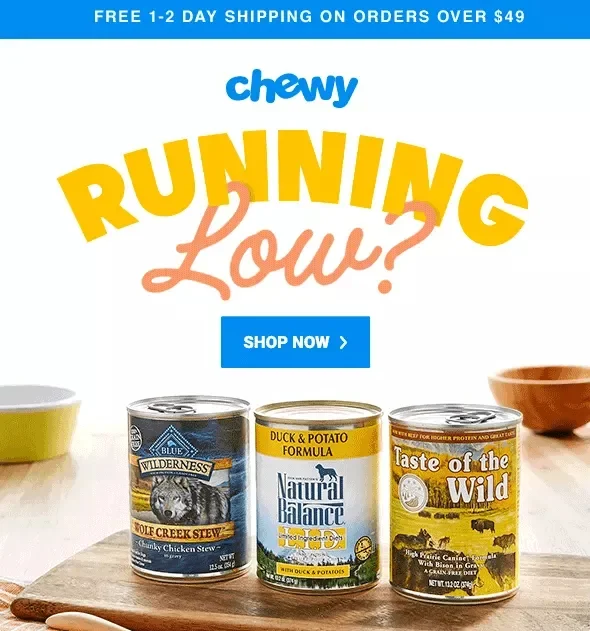
The following best practices will help you guarantee the success of your replenishment campaigns.
- Include the actual product in your remarketing email campaigns
- Give a discount to motivate shoppers to buy
- Send the retargeting emails early to give the shopper enough time to plan
Win-back (re-engagement) email
Brand: Basic Piece
Win-back emails are meant to help marketers regain the interest of subscribers who’ve stopped engaging with the brand. Considering how difficult it is to acquire new customers, you shouldn’t let your existing ones slip through the cracks even after a long period of inactivity.
With win-back retargeting emails, you can remind such users of your value and encourage them to visit your website to check out a few products. The image below shows a re-engagement email to re-establish contact with a subscriber who had gone quiet.

The email contains several products the customer may be interested in and buttons that lead to the product pages. When designing your win-back emails, pay attention to the following:
- Use a catchy subject line to draw people in
- Give recommendations the subscriber will enjoy
- Use a straightforward tone
- Offer discounts to attract customers to your online store
How to create a retargeting email
Are you convinced of the benefits of email retargeting and want to create remarketing emails for your subscribers? Omnisend’s versatile email builder has all the features you need to create highly-targeted email retargeting campaigns.
To get started with Omnisend, you first need to create an account using this link. The account creation process is seamless and allows you to enjoy amazing features, such as a feature-rich free plan and excellent customer support.
In this section, we’ll teach you how to create retargeting emails with Omnisend, particularly one to re-engage users who have browsed products on your website and left without making a purchase.
Create a new campaign
After creating your account, you can use Omnisend’s automation features to create your retargeting emails. To create a new campaign, click on the Automation tab from your dashboard and click on “Browse pre-built workflows.“
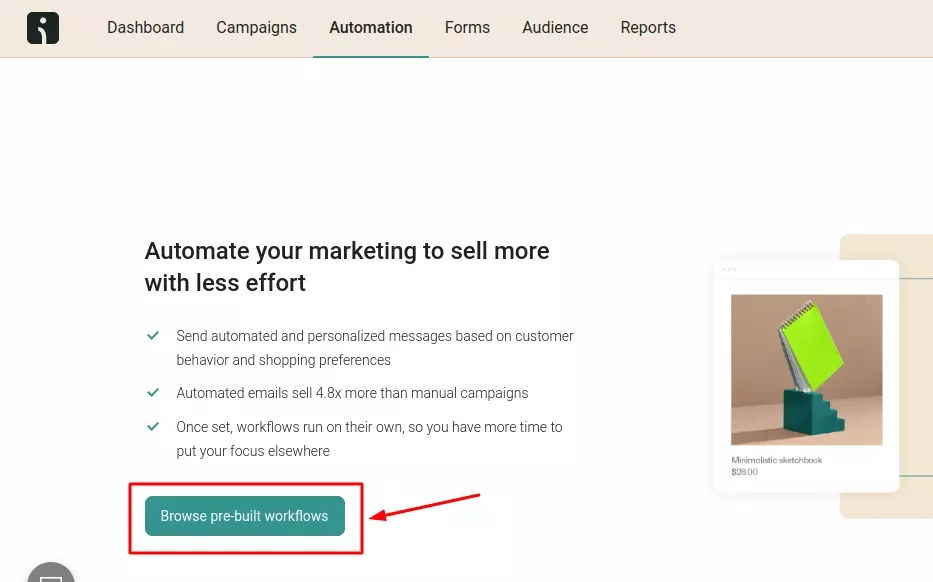
Choose an automation workflow
Clicking on the “Browse pre-built workflows” button will take you to a page where you can choose an automation workflow for your email retargeting campaign.
Scroll down the page and choose “Browse Abandonment” in the workflows. Alternatively, use the filters and click “Browse Abandonment” from the sidebar to find your workflow faster.
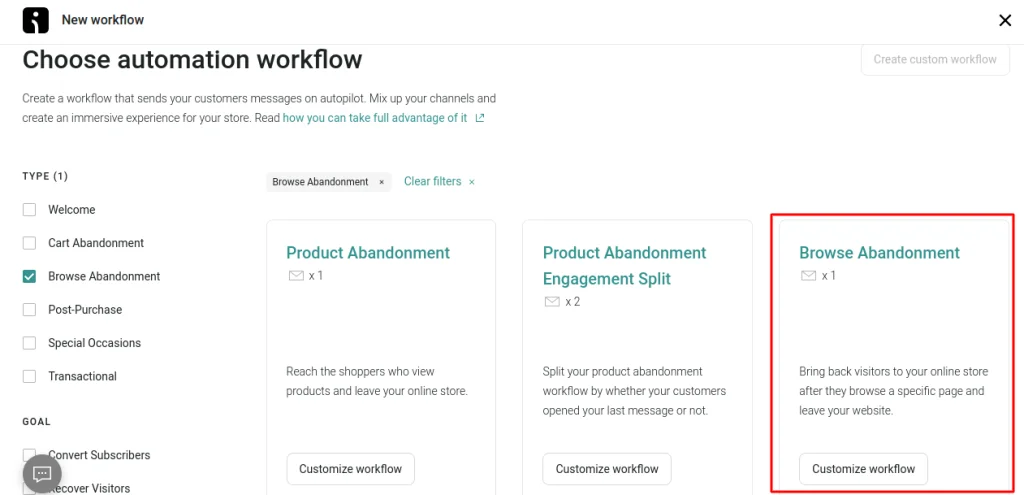
Customize the workflow
Click on the “customize workflow” button to begin customizing your browse abandonment retargeting email. This will open a window that allows you to set your campaign triggers and craft your messages.
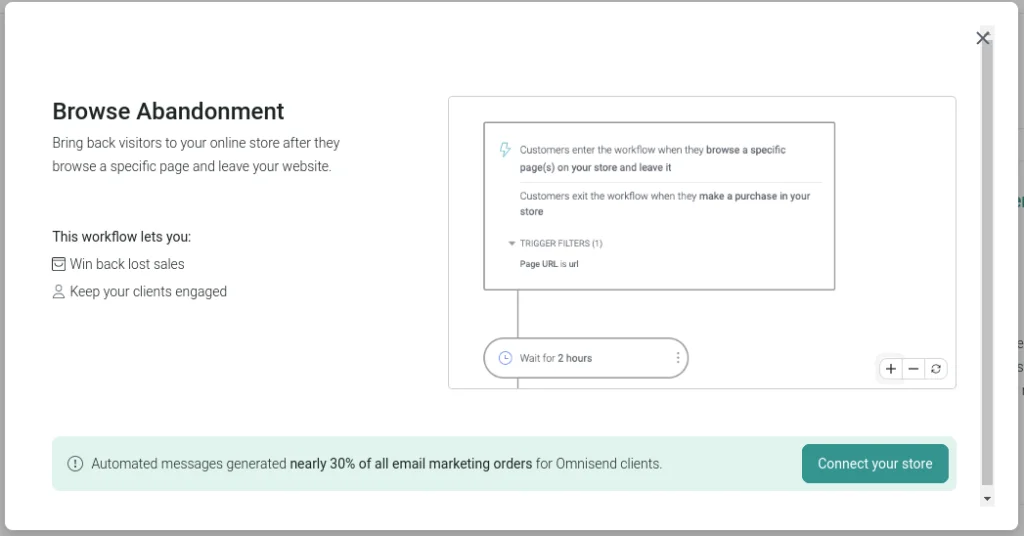
Save the workflow
The last step is to save the changes you’ve made. After saving your workflow, choose the email recipients and adjust your sending settings. Be careful with this step to ensure emails are highly-targeted and relevant to the recipients.
Summary
Customers want brands to send them the right messages and no marketing strategy does this better than email retargeting. By collecting relevant information about your subscribers, you can re-engage them with personalized messages to drive them into action.
Use the examples and strategies highlighted in this post to create amazing retargeting emails to maximize sales and improve your conversion rate.
Source from Omnisend
Disclaimer: The information set forth above is provided by Omnisend independently of Alibaba.com. Alibaba.com makes no representation and warranties as to the quality and reliability of the seller and products.
